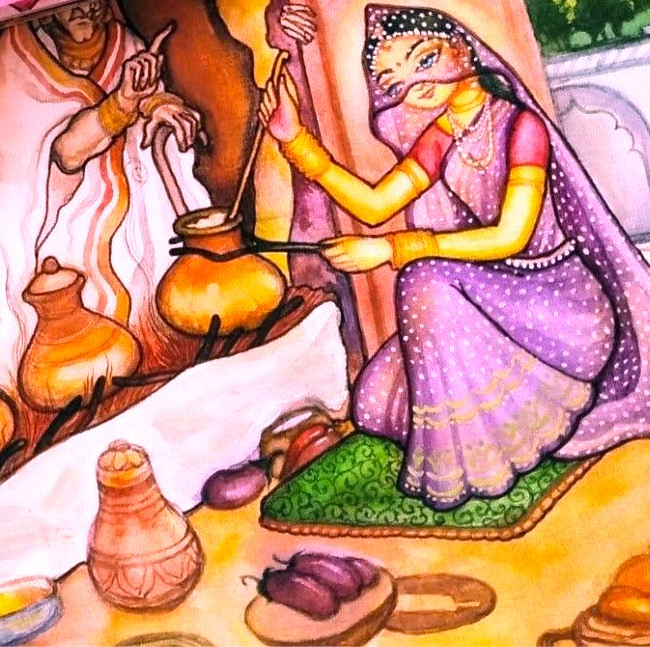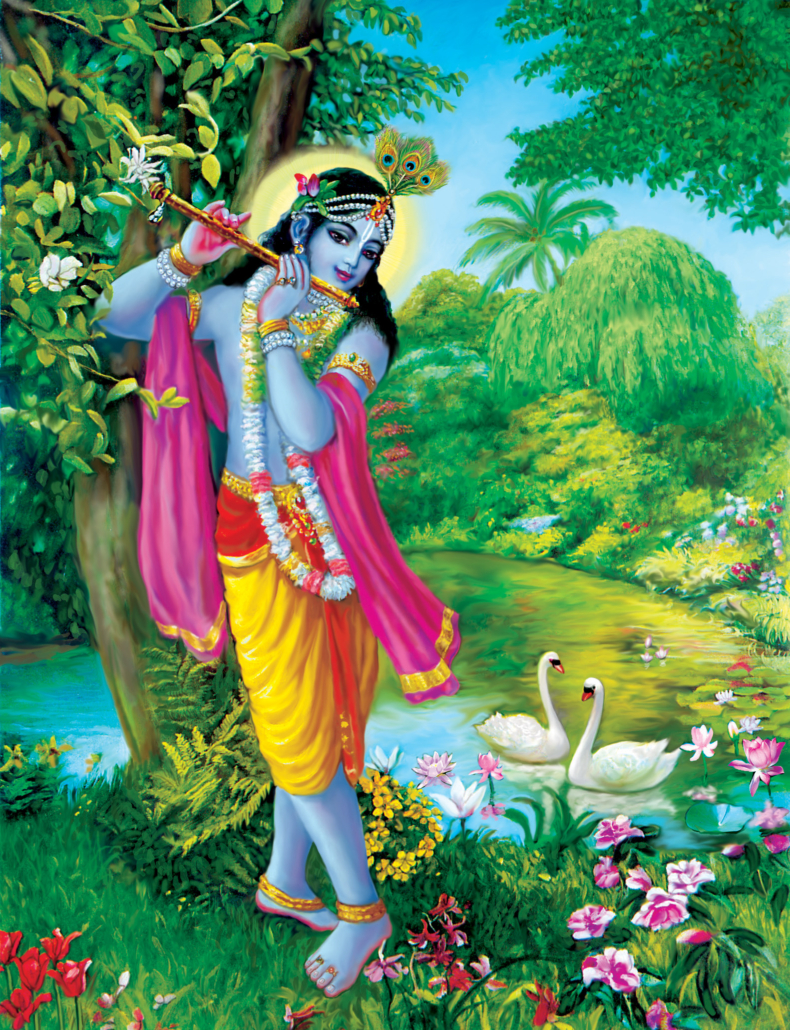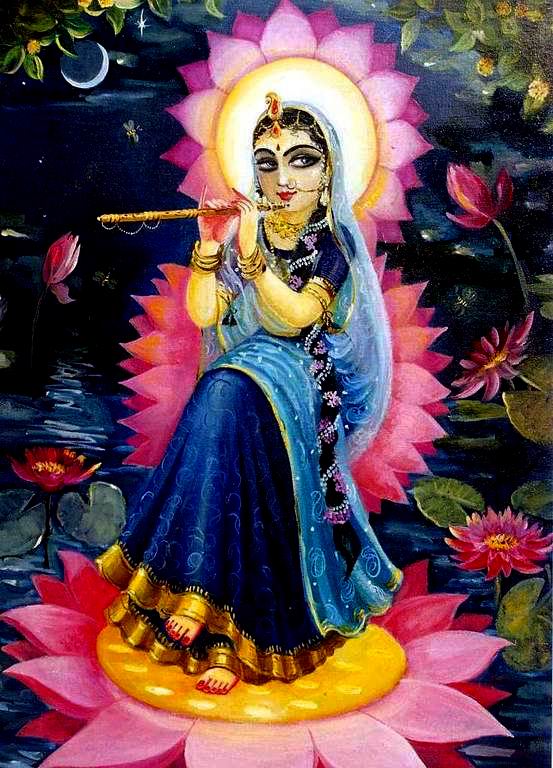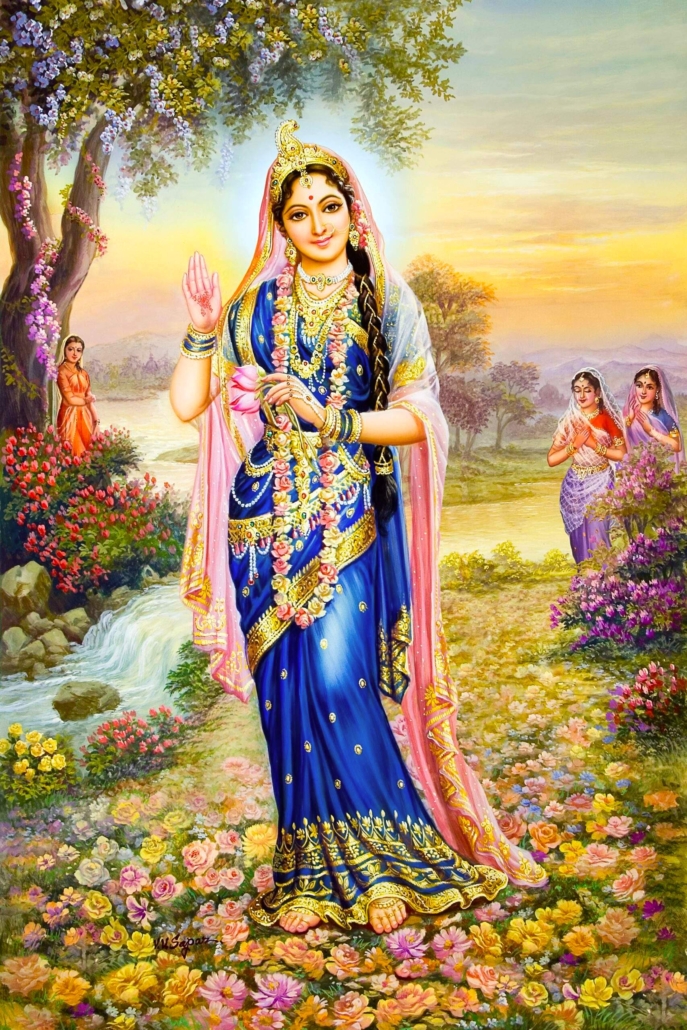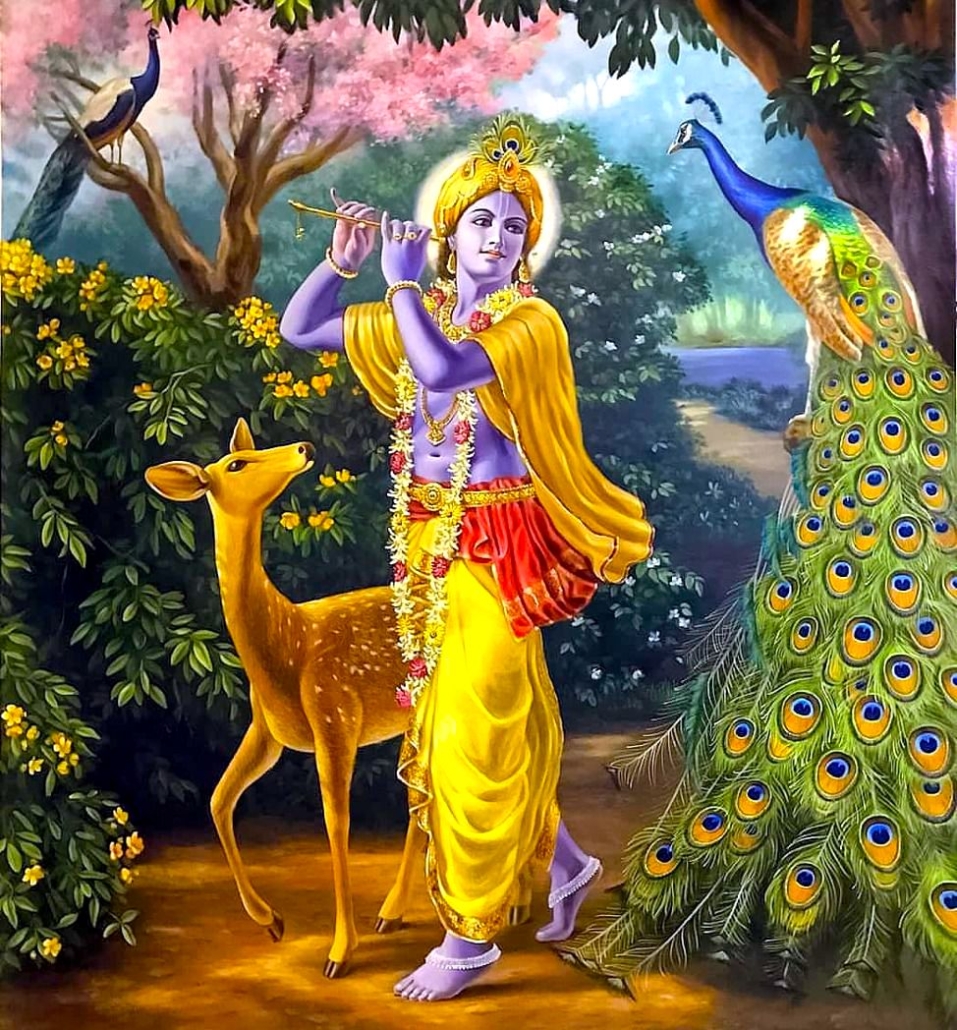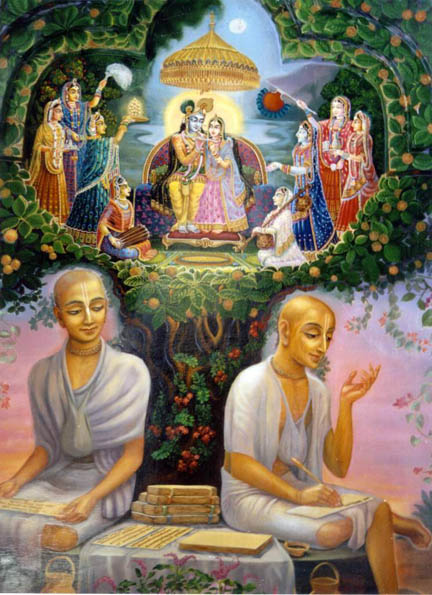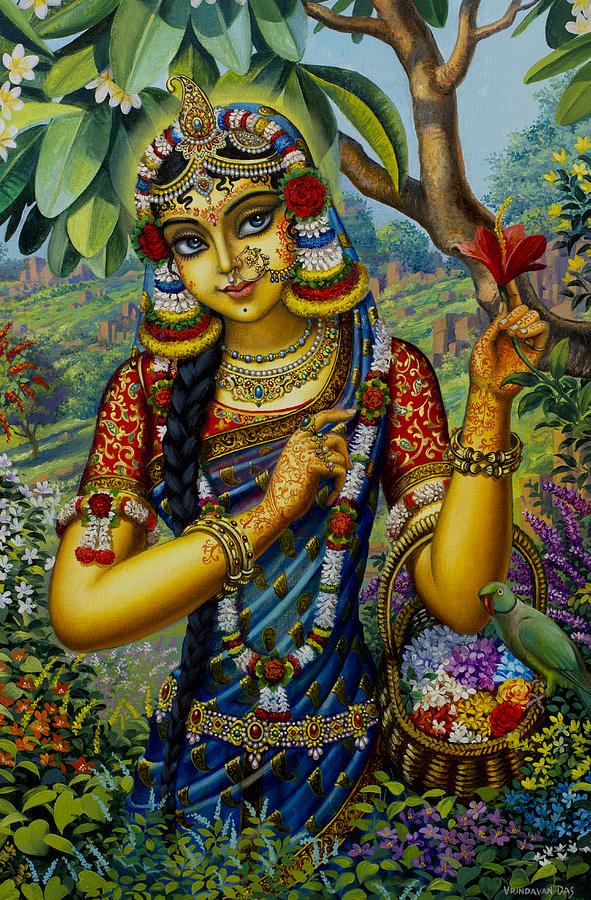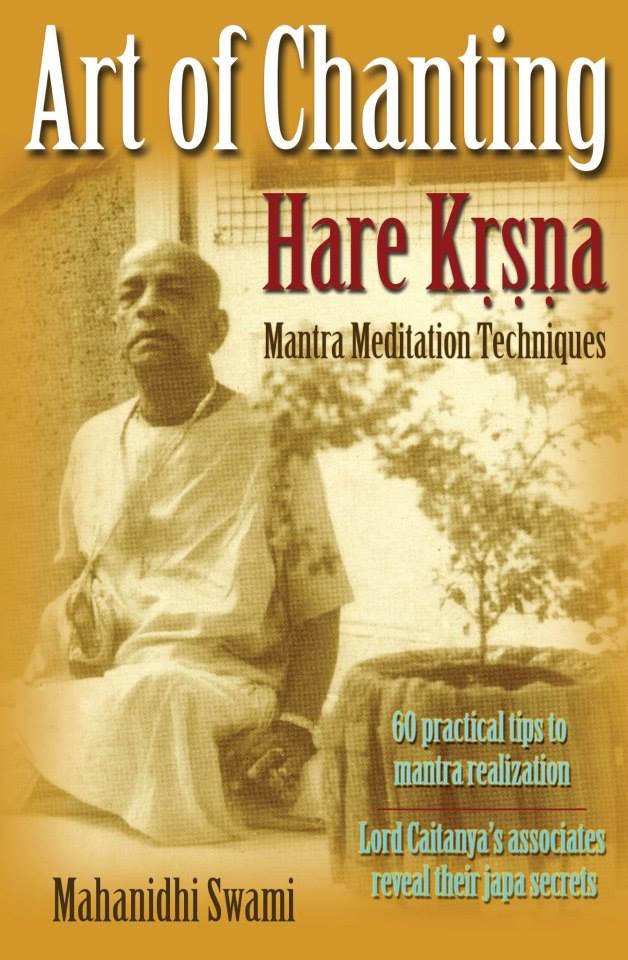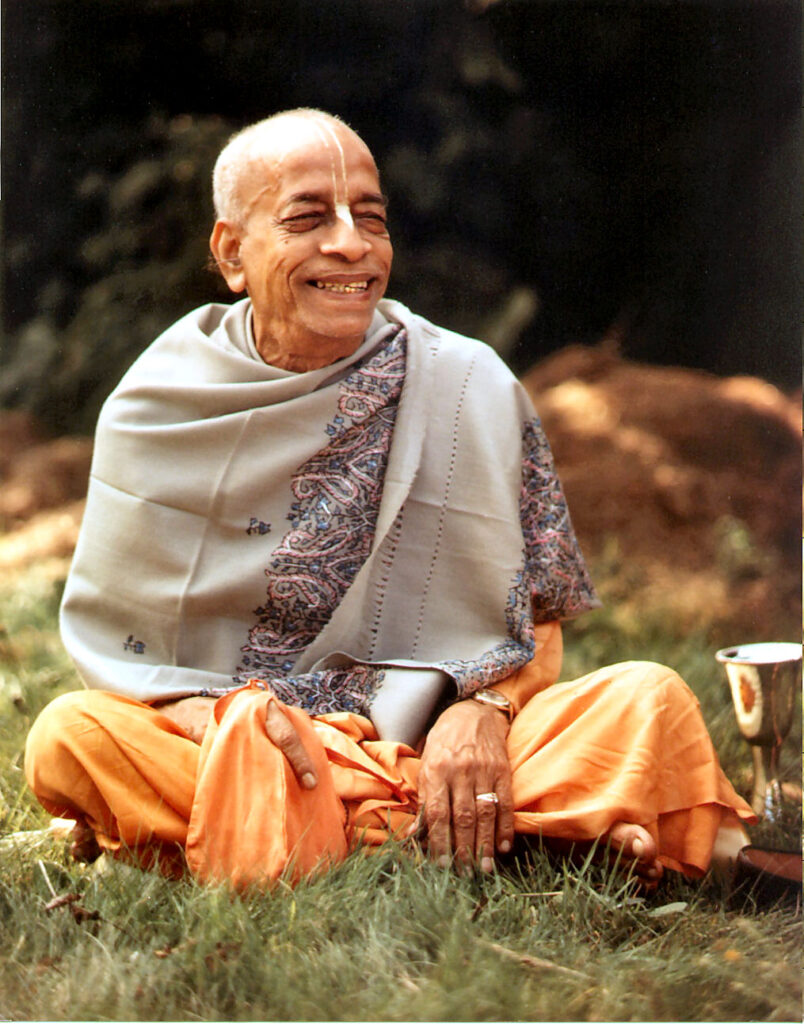Mahanidhi Madan Gopal Das
In Hari-bhakti vilasa, Srila Sanatana Goswamipada writes 276 verses telling how to observe Sri Krishna Jayanti. But he did not mention one verse about observing Radhastami. Gaudiya Vaisnavas worship Radha Govinda Yugala with special emphasis on serving and pleasing Sri Radha (radhadasyam). Therefore, on Radhastami many Gaudiyas do special worship and vratas to please their eternal Ishvari and Swamini Sri Radha.
Here we will list many wonderful sevas devotees may do to please Karunamayi Radhika with special pujas, offerings and prayers. Jai Jai Sri Radhe!
* 1. WAKING RADHASTAMI SANKALPA:
Upon rising from bed, take a sankalpa (firm vow): Before a murti or painting of Radharani pray, “O Karunamayi Radha! On this most beautiful and auspicious day of Your divine appearance, I will try my best to remember, serve, glorify and please You. O Vrindavaneshvari! Please be merciful and bless this most unworthy one with the eternal service of Your delicate, fragrant and sweet lotus feet.”
* 2. CHANT AT 6 A.M. TO 8:24 A.M. LORD CHAITANYA’S RADHA PRAYER:
Mahaprabhu personally wrote the following prayer and gave this benediction: “Any devotee who recites (at this time) these 108 names of Sri Radhika will attain ecstatic love for Lord Krishna.”
ŚrīRādhikā-Aṣṭottara-Śata-Nāma-Stotram108 Names of ŚrīRādhikā
śrīmad-rādhā rasa-mayī, rasa-jñārasikātathā
rāseśvarī rasa-bhaktī, rasa-pūrṇa rasa-pradā (1)
ŚrīRādhā is endowed with all the most splendrous opulences, and is completely pervaded with ever-flowing transcendental mellows. She fully understands the subtleties of these mellows. Rādhā is adept in relishing mellows. Rādhikā is the Queen of the nightly rāsa dance. She is totally devoted to expressing divine mellows. Śrī Rādhā is full to overflowing with pure mellows. She bestows these exquisite mellows unto everyone.
raṅgiṇī rasa-lubdhāca, rāsa-maṇḍala-kāriṇī
rasa-vilāsinīrādhā, rādhikā rasa-pūrṇadā (2)
Rādhā is always very playful. She is greedy to taste newer and newer aspects of mellows. Rādhā is the designer of the circular arenas for rāsa dancing. She enjoys sporting the rāsa dance to Her heart’s content. Rādhā is the best worshiper of Śyāma. Rādhikā, the best worshiper, is adored intimately by Her friends. She bestows mellows unto others in the most completely fulfilling way.
rāmā-ratnāratna-mayī, ratna-mālāsu-śobhanā
raktoṣṭhirakta-nayanā, raktotpala-vidhāriṇī (3)
ŚrīRādhā is the topmost jewel among all the many forms of Lakṣmī-devī. All of Her ornaments and paraphernalia are studded with precious jewels. Rādhikā likes to wear gemstone necklaces. Rādhā radiates the nicest, purely sublime splendor. Her lips are naturally hued with a charming redness. The corners of ŚrīRādhā’s eyes are hued with reddish tints. She especially likes to hold a red lotus flower in Her hand.
ramaṇīrāmaṇīgopī, vṛndāvana-vilāsinī
nānā-ratnāvicitrāṅgī, nānā-sukha-mayīsadā (4)
Rādhārāṇī is a charming young mistress. Her loveliness is especially pleasing to behold. Rādhā is a cowherd girl. She likes to frolic in the forest of Vṛndāvana. Rādhā is fond of wearing different types of gemstones. The shapes of Rādhārāṇī’s limbs are astonishingly lovely to behold. She abounds in various forms of happiness.
saṁsāra-pāra-tāraṇī, venu-gītā-vinodinī
kṛṣṇa-priyākṛṣṇa-mayī, kṛṣna-dhyāna-parāyaṇī (5)
Rādhārāṇī delivers souls out of the material world. She takes great pleasure in listening to flute songs. Rādhā is very dear to Kṛṣṇa. She is Lord Kṛṣṇa’s exact counterpart. Rādhā is fond of meditating upon ŚrīKṛṣṇa.
sadānandākṣīṇa-madhyā, kṛṣṇākṛṣṇālayāśubhā
candrāvalīcandra-mukhī, candrācakṛṣṇa-vallabhā (6)
Rādhikā is always full of bliss. Her waist is very slim. Rādhā is the female form of Kṛṣṇa Himself. She is the refuge of Her beloved Kṛṣṇa. Rādhārāṇī is the embodiment of auspiciousness. She is beautiful as a series of full moons. Rādhā’s face is round, and radiantly soothing like a full moon. She is the very personification of the moon itself. Rādhā is the dearmost beloved of Lord Kṛṣṇa.
vṛndāvaneśvarīdevī, kṛṣṇa-raṅgīparā-gatiḥ
dhyānātītādhyāna-magnā, sadā-kṛṣṇa-kutūhalī (7)
Rādhārāṇī is the Queen of Vṛndā’s forest. She is the Supreme Goddess of the entire creation. Rādhā enjoys playing fun games with Kṛṣṇa. ŚrīmatīRādhārāṇī is the final transcendental goal. She is naturally situated far, far beyond anyone’s meditation. Rādhā is very meditative by nature. She is always playing mischievous pranks on Kṛṣṇa.
prema-mayīprema-rūpā, premāprema-vinodinī
kṛṣṇa-priyāsadānandī, gopī-maṇḍala-vāsinī (8)
Rādhikā is effused with the purest ecstatic love. She is the embodiment of love’s most beautiful form. Her every thought, action, word and deed is totally saturated with love. She revels in the delightful sports of pure love. Rādhā is the favorite of Lord Kṛṣṇa. She is perpetually absorbed in the greatest happiness. Rādhārāṇī resides within the circle of Her cowherd girlfriends.
sundarāṅgīcasvarṇābhā, nīla-paṭṭa-vidhāriṇī
kṛṣṇānurāgiṇīcaiva, kṛṣṇa-prema-su-lakṣaṇā (9)
Rādhā’s bodily limbs are all very attractive. Her complexion is radiantly golden. Rādhā especially likes to wear blue silken garments. She is very contented in Her attachment to Kṛṣṇa. ŚrīmatīRādhārāṇī is nicely marked by Her obvious love for Kṛṣṇa.
nigūḍha-rasa-sāraṅgī, mṛgākṣīmṛga-locanā
aśeṣa-guṇa-pārāca, kṛṣṇa-prāṇeśvarīsamā (10)
Rādhā embodies variegated forms of confidential mellows. Her eyes are just like those of a dear. Rādhā views things innocently like a dear. She excels even beyond limitless good qualities. Rādhārāṇī is the mistress of the very life-breath of Kṛṣṇa. She is equal in Her dealings with all.
rāsa-maṇḍala-madhyasthā, kṛṣṇa-raṅgīsadāśuciḥ
vrajeśvarīvraja-rūpā, vraja-bhūmi-sukha-pradā (11)
Rādhā dances in the center of the circular rāsa dance. She enjoys frolicking with Lord Kṛṣṇa. Rādhārāṇī always has immaculate manners. ŚrīmatīRādhārāṇī is the Queen of Vraja-dhāma. Aspects of Her form are visible in all the natural features throughout Vraja. ŚrīRādhā is the grantor of happiness to all beings in Vraja-bhūmi.
rasollāsāmadonmattā, lalitā rasa-sundarī
sarva-gopī-mayīnityā, nānā-śāstra-viśāradā (12)
Rādhā especially blossoms with delight during the rāsa dance. She becomes wildly intoxicated by drinking honey-wine. Rādhā embodies the most charming loveliness. She is the truly beautiful expression of divine loving mellows. She expands Herself into multiple forms as all the cowherd girls. Rādhā is the essence of eternity. She is greatly learned in various scriptures.
kāmeśvarīkāma-rūpā, sadākṛṣṇa-parāyaṇā
parā-śaktī-svarūpāca, sṛṣṭi-sthiti-vināśinī (13)
Rādhā is the Queen of transcendental lust. She is the personification of divine desire. ŚrīRādhikā is always cherishing Kṛṣṇa. She is the very figure of divine potency. Rādhā is the annihilator of the material creation.
saumyāsaumya-mayīrādhā, rādhikāsarva-kāmadā
gaṅgācatulasīcaiva, yamunācasarasvatī (14)
Rādhā is pleasing like the moon. All of Her dealings are soft and gentle. She is endowed with all prosperity and success. Rādhā fully satisfies Her beloved by Her intimate worship. She fulfills the aspirations of all beings. ŚrīRādhā is the original form of the Ganges River. She is the original form of the holy basil plant. She is the original form of the Yamunā River. Rādhā is the original form of the Sarasvatī River.
bhogavatībhagavatī, bhagavac-citta-rūpiṇī
prema-bhakti-sadā-saṅgī, premānanda-vilāsinī (15)
ŚrīmatīRādhārāṇī is the original form of the Bhogavatī river [the Ganges flowing in the Pātāla region. She is the Supreme female divinity. Rādhā is the embodiment of Bhagavān’s very heart. She is continuously associated with ecstatic loving devotion. Rādhā cavorts in the ecstatic bliss of pure love.
sadānanda-mayīnityā, nitya-dharma-parāyaṇī
trailokyākarṣaṇīādyā, sundarīkṛṣṇa-rūpiṇī (16)
Rādhikā is perpetually permeated with exhilaration. She is the incarnation of agelessness. Rādhā is devoted to performing auspicious daily rituals. She is the attractor of the three worlds. ŚrīRādhā is the original source of all that is. She is the absolute manifestation of total beauty. Rādhārāṇī expresses Herself as the form of Lord Kṛṣṇa.
śatam-aṣśṭottaraṁnāma, yaḥpaṭhetprayataḥśuciḥ
prātaḥ-kālecamadhyāhne, sandhyāyāṁmadhya-rātrike
yatratatrabhavettasya, kṛṣṇaḥprema-yutobhavet (17)
If a pious and clean devotee recites these 108 holy names of ŚrīRādhikā — either in the morning [6-8:24a.m.], evening [6-8:24p.m.], or in the middle of the night [10:48p.m.-3:36a.m.]– wherever and however that person lives, they become endowed with ecstatic love for Lord Kṛṣṇa.”
* 3. CHANT RADHA PRANAM PRAYERS:
As a love offering to Sukumari Radha on Her Divinely wonderful birthday, memorize the following short prayers, or others, and chant them for Sundari Radha’s pleasure:
tavaivāsmitavaivāsminajīvāmitvayāvinā
itivijñāyadevitvaṁnayamāṁcaraṇāntikam (1)
“O Radhe, I am Yours! I am Yours! I cannot live without You! O Radhe, please understand this and bring me to the service of Your lotus feet.” (ŚrīVilāpa-kusumāñjali 96)
bhajāmirādhāṁaravinda-netrāṁ
smarāmirādhāṁmadhura-smitāsyāṁ
vadāmirādhāṁkaruṇā-bharārdrāṁ
tatomamānyāstigatirnakāpi (2)
I worship Rādhā who has lotus eyes, I remember Rādhā who has a sweet smile, and I speak of Rādhā who is melted with compassion. There is nothing else for me. She is my life and soul.(ŚrīViśākhānandadābhidha-stotram 131)
* 4. HEAR AND READ RADHA KATHA:
Hear lectures and read books glorifying the astonishing name, form, qualities, pastimes and loving service of Radharani (e.g. Radha-Krishna Ganoddesha Dipika, Vilapa Kusumanjali, Radha Rasa Sudhanidhi, Sankalpa Kalpadruma, Govinda Lilamrta, Ujjvala-nilamani, and Caitanya-caritamrta, adi four and other chapters see index.
* 5. SING RADHA BHAJANS & RADHA NAMA KIRTANA:
a. RĀDHĀRĀṆĪ KĪ JAI! MAHĀRĀṆĪ KĪ JAI!
(rādhāraṇīkī jai, mahārāṇīkī jai.bolo barṣāṇevārīkī jai jai jai)
ṭhākurāṇīkī jai, haripyārīkī jai
vṛṣabhānu-dulārīkī jai jaijai
gaurāṅgīkī jai, hemāṅgīkī jai
vrajarāja-kumārikī jai jaijai
vrajā-rānīkī jai, vrajadevīkī jai
gahvaravanavārīkī jai jaijai
All glories to Rādhārāṇī! All glories to the greatest of all Queens. Sing the glories of Rādhārāṇī, who lives in Barṣāṇā.
All glories to RādhāṬhākurāṇī [Queen Rādhā], who is the beloved of ŚrīHari. All glories to the beloved daughter of King Vṛṣabhānu.
All glories to Rādhārāṇī who has a fair complexion and golden limbs.
All glories to the Queen of Vraja. All glories to the goddess of Vraja. All glories to Rādhā who wanders in the Gahvara forest.
b. jaya jaya radhe, jaya jaya shyama,
jaya jaya sri Vrindavana dhama.
Pavana Radhe tero nama
Pavana sri Vrindavana dhama.
Jaya jaya Shyamaa, jaya jaya Shyama,
Jaya jaya sri Vrindavana dhama.
“All glories, all glories to Radhe-Shyama! O Radha, Your Holy Name is completely purifying and so is Your beautiful abode named Vrindavana. All glories to You, the Golden One whose heart is brimming with Shyama-rasa. And all glories to Your dark Lord of Love—the sweet heart stealer of Vraja.”
c. Maine RaṭanāLagāiRādhāNāmakīTraditional Brijbhāshā Song (Rasiyā)
(refrain) maineraṭanālagāirādhānāmakī
maineraṭanālagāirādhānāmakī
(1) merīpalakoṅmeṅrādhā, merīalakoṅmeṅrādhā
mainemāṅgabharāirādhanāmakī
Rādhā is there in the blinking of my eyes. Rādhā is there in the curls of my hair I have filled up the very part of my hair Oh! With the sweet name of Rādhā.
(2) merenainoṅmeṅrādhā, mere bainoṅmeṅrādhā
mainebainīguthāirādhanāmakī
Rādhā is there within my vision. Rādhā is there within my speech. I interweave my every word Oh! With the sweet name of Rādhā.
(3) merīdularīmeṅrādhā, merīcunarīmeṅrādhā
mainenathanīsajāirādhanāmakī
Rādhā is there in my necklace. Rādhā is there in my sārī. I have adorned my nose-ring Oh! With the sweet name of Rādhā.
(4)merecalanemeṅrādhā, mere halanemeṅrādhā
kaṭikiṅkinībajāirādhanāmakī
Rādhā is there in my walking. Rādhā is there in my gestures. My sash of waist-bells resounds Oh! With the sweet name of Rādhā.
(5)meredāyebāyerādhā, mere āgepīcherādhā
romaroma rasa chāirādhanāmakī
Rādhā is there on my right and on my left. Rādhā is there in front of me and behind.My every fiber reflects the rasa flowing,Oh! With the sweet name of Rādhā.
(6)mereaṅgaaṅgarādhā, mere saṅgasaṅgarādhā
Rādhā is there on my each and every limb. Rādhā is there accompanying me always. Lord Gopāl plays His flute which calls out, Oh! With the sweet name of Rādhā.
d. Jaya Rādhe, Jaya RādheRādhe
HariVyāsaDevācārya
nava-navaraṅgi tri-bhaṅgijaya, syāmasu-aṅgisyāma
jayarādhejayahari-priye, śrī-rādhesukhadhāma
(introductory verse) “All glories to Sri Krishna who stands in a beautiful three-fold stance! Shyama is the connoisseur of newer and newer playful sports, and His body is effulgent with the nicest dark complexion.
All glories to You, Rādhe! All glories to You, O Hari-priyā! O ŚrīRādhe! You are the abode and reservoir of all happiness!”
Refrain:(1) jayarādhe jayarādherādhe jayarādhe jayaśrī-rādhe
jayakṛṣṇa jayakṛṣṇakṛṣṇa jayakṛṣṇa jayaśrī-kṛṣṇa
(2) syāmāgorīnitya-kisorīprītama-jorīśrī-rādhe
rasikarasīlochaila-chabīloguṇa-garabīlośrī-kṛṣṇa
O ŚrīRādhe! You are:
Syāmā—a fresh young maiden with slender waist, endowed with the luster of new adolescence;
Gorī—You possess the fairest golden complexion;
Nitya-kisorī—You are eternally situated in the sweet blossoming of divine youth;
Prītama-jorī—You are the only perfect match for Your most Beloved.
O ŚrīKṛṣṇa! You are:
Rasika—the true relisher of transcendental mellows;
Rasīlo—You are sweet and relishable in every aspect;
Chaila-chabīlo—You are so effulgent that You represent the topmost super excellence of pure enchantment;
Guṇa-garabīlo—You are situated in great pride due to full awareness of Your own transcendental qualities.
(3) rāsa-vihārini rasa-bisatārinipiya-ura-dhāriniśrī-rādhe
nava-nava-raṅgīnavala-tribhaṅgīsyāma-su-aṅgīśrī-kṛṣṇa
O ŚrīRādhe! You are:
Rāsa-vihārini—the sportive Princess of the ecstatic rāsa-dance festival, which You organize every night;
Rasa-bisatārini—You are the distributor of pure ecstatic rasa-mellows to all other living entities;
Piya-ura-dhārini—You love to embrace the chest of Your Lover.
O ŚrīKṛṣṇa! You are:
Nava-nava-raṅgī—the connoisseur of newer and newer playful sports;
Navala-tribhaṅgī—You like to stand in a three-fold bending posture that always appears ever-fresh;
Syāma-su-aṅgī—Your body is perfectly exquisite in both proportion and deep dark complexion.
(4) prāna-piyārīrūpa-ujyārīati-sukuṅvārīśrī-rādhe
maina-manoharamahā-moda-karasuṅdara-bara-taraśrī-kṛṣṇa
O ŚrīRādhe! You are:
Prāna-piyārī—the most dear loving friend of everyone’s life;
Rūpa-ujyārī—You manifest a brilliant splendor of sheer beauty;
Ati-sukuṅvārī—You are extremely soft and delicate due to Your fresh youth.
O ŚrīKṛṣṇa! You are:
Maina-manohara—the enchanter of the mind of Cupid;
Mahā-moda-kara—You are the giver of great transcendental bliss to all living entities;
Sundara-bara-tara—Your beauty surpasses the best by far.
(5) sobhā-sainīmobhā-mainīkokila-bainīśrī-rādh
kīrati-vantākāmini-kaṅtāśrī-bhagavaṅtāśrī-kṛṣṇa
O ŚrīRādhe! You are:
Sobhā-sainī—the manifestor of wonderful beauty while You are gracefully reclining on a flower bed;
Mobhā-mainī—You radiate the luster of the transcendental Cupid, Lord Kāmadeva;
Kokila-bainī—Your speech sounds just like the soft, gentle cooing of the cuckoo bird.
O ŚrīKṛṣṇa! You are:
Kīrati-vaṅtā—honored by Your own glorious fame;
Kāmini-kaṅtā—You are the lover of lusty young gopīs;
Śrī-bhagavaṅtā—Your position is the highest amongst all the different forms of Godhead.
(6) caṅdā-badanīkuṅdā-raḍanīsobhā-sadanīśrī-rādhe
parama-udārāprabhā-apārāati-sukuṅvārāśrī-kṛṣṇa
O ŚrīRādhe! You are:
Chaṅdā-badanī—the possessor of a spotless moon-face;
Kuṅdā-raḍanī—Your teeth look just like small round jasmine flowers;
Sobhā-sadanī—You are the very abode of majestic beauty and splendor.
O ŚrīKṛṣṇa! You are:
Parama-udārā—the most supremely magnanimous personality;
Prabhā-apārā—Your bodily aura radiates out into unlimited eternity;
Ati-sukuṅvārā—You are naturally endowed with the softness of extremely youthful charms.
(7) haṁsā-gavanīrājati-ravanīkrīḍā-kavanīśrī-rādhe
rūpa-rasālānaina-bisālāparama-kṛpālāśrī-kṛṣṇa
O ŚrīRādhe! You are:
Haṁsā-gavanī—fond of walking like a majestic swan;
Rājati-ravanī—You are the most radiant lover;
Krīḍā-kavanī—You are the instigator of many fun sports and contests.
O ŚrīKṛṣṇa! You are:
Rūpa-rasālā—the embodiment of the most relishable type of beauty;
Naina-bisālā—Your lotus eyes are large and wide;
Parama-kṛpālā—You are the topmost merciful personality.
(8)kaṅcana-belīrati-rasa-relīati-alabelīśrī-rādhe
saba-sukha-sāgarasaba-guṇa-āgararūpa-ujāgaraśrī-kṛṣṇa
O ŚrīRādhe! You are:
Kaṅcana-belī—just like a golden creeper wound around the Śyāmatamāla-tree;
Rati-rasa-relī—You are completely full to the brim with the ecstatic mellows of purely divine love;
Ati-alabelī—Your unique activities are conducted in complete privacy.
O ŚrīKṛṣṇa! You are:
Saba-sukha-sāgara—the ocean of all types of happiness;
Saba-guṇa-āgara—You are the mine of all good qualities;
Rūpa-ujāgara—You radiate a famous aura of glorious beauty.
(9) ravanī-ramyātara-tara-tamyāguṇa-agamyāśrī-rādhe
dhāma-nivāsīprabhā-prakāsīsahaja-suhāsīśrī-kṛṣṇa
O ŚrīRādhe! You are:
Ravanī-ramyā—the most charming mistress of Your beloved;
Tara-tara-tamyā—You are naturally situated at the topmost level of successive greatness;
Guṇa-agamyā—Your divine qualities are imperceptible to ordinary senses or minds.
O ŚrīKṛṣṇa! You are:
Dhāma-nivāsī—a permanent resident of the holy abode of ŚrīVraja;
Prabhā-prakāsī—You radiate a most influential aura;
Sahaja-suhāsī—You naturally wear a pleasant smile.
(10) śaktyāhlādiniati-priya-vādiniura-unmādiniśrī-rādhe
aṅga-aṅga-taunasarasa-salaunasubhaga-suthaunaśrī-kṛṣṇa
O ŚrīRādhe! You are:
śaktyāhlādini—the very potency of divine pleasure
Ati-priya-vādini—Your speech is such that whoever hears it becomes lovingly attached to it
Ura-unmādini—Your breasts are crazed with the wildest desire to be satisfied by Your Beloved.
O ŚrīKṛṣṇa! You are:
Aṅga-aṅga-tauna—endowed with such bodily limbs that each and every aspect of them is very captivating;
Sarasa-salauna—Your beauty is indeed saturated with an all-pervading, overflowing rasa-current;
Subhaga-suthauna—Your chest is beautifully endowed with majestic divine opulences.
(11) rādhā-nāminiguṇa-abhirāminihari-priya-svāminīśrī-rādhe
hare-hare-hari hare-hare-hari hare-hare-hariśrī-kṛṣṇa
O ŚrīRādhe! You are:
Rādhā-nāmini—celebrated with the most blessed name of “Rādhā”
Guṇa-abhirāmini—You please everyone with your good qualities;
Haripriya-svāmini—You are the only worshipable Queen for Haripriya
[the author, HariVyāsadeva].
Hare HareHari, Hare HareHari,
Hare HareHari, ŚrīKṛṣṇa
* 6. COOK RADHA’S FAVORITE PREPS:
Here’s a recipe said to a favorite of Rasika-rani Radha:
main ingredients:
• 10-12 arbi
• ½ tsp carom seeds/ajwain
• ½ tsp turmeric powder
• ½ tsp garam masala powder
• 2 tbsp oil
• 2 cups water
• salt as required
• some mint & coriander for garnishing
for making the paste:
• 3 medium size tomatoes
• 1 green chili
• ½ inch ginger
• 1 tsp cumin
INSTRUCTIONS
1. wash the arbi well.
2. pressure cook the arbi till cooked.
3. drain and let the arbi cool.
4. when warm or cool, peel the skin and slice the arbi in to 2 or 4 pieces vertically.
5. grind all the ingredients mentioned for making the paste to a smooth paste.
6. heat oil.
7. add the carom seeds and fry them.
8. then add the tomato paste.
9. stir and add all the spice powders one by one.
10. fry the tomato paste till the oil separates.
11. this will take about 6-7 minutes.
12. then add water, rock salt and the boiled arbi pieces,
13. simmer for some 6-7 minutes till the gravy becomes smooth and thickens a little bit.
14. garnish with mint or coriander leaves and serve arbi curry to Rasika-rani Radha.
* 7. NOONTIME RADHARANI PUJA:
If you have Deities then worship with a variety of wonderful items per your standard and more. If you only have a painting or Deity photo of Sri Radha, then worship that form of Radharani externally with a delicious bhoga offering, aroti, fragrant flower garlands and scents, all followed by a euphoric kirtana!
Internally as manasic-puja, you can offer many, many bhoga preparations to your painting/ photo murti of Shyama-priya. You can bathe Radharani with pancha-amrta, and thousands of juices, nectars and waterfalls of jeweled-inlaid tears. Then you can dress Rai-vinodini in a splendidly stunning designer outfit with elaborate decorations and ornaments—all of flowers, especially blue lotus and every other exotic tropical flower you can think of.
Your mind is an unlimited temple, wherein you are completely free to worship Srimati Radharani in an infinite number of sweet, intimate and beautiful ways. Open the garden of your heart and decorate Kishori with the flowers of all your love!
Jai Jai Sri Radhe!
* 8. FULL DAY RADHA ABSORPTION:
After noon puja, you can spend the whole day pleasing Sri Radha with reading, speaking, kirtana, dancing and bhajanas—all focused on bringing bliss to Sukumari Radha.
After all this absorption, close your eyes, meditate on all that you have received, and then glide through the wee hours of the night chanting the Radha-Krishna Yugala Maha Mantra:
Hare Krishna Hare Krishna Krishna Krishna Hare Hare
Hare Rama Hare Rama Rama Rama Hare Hare
SRI RADHASTAMI MAHA MAHOTSAVA KI JAI!
Jai Jai Sri Radhe!

